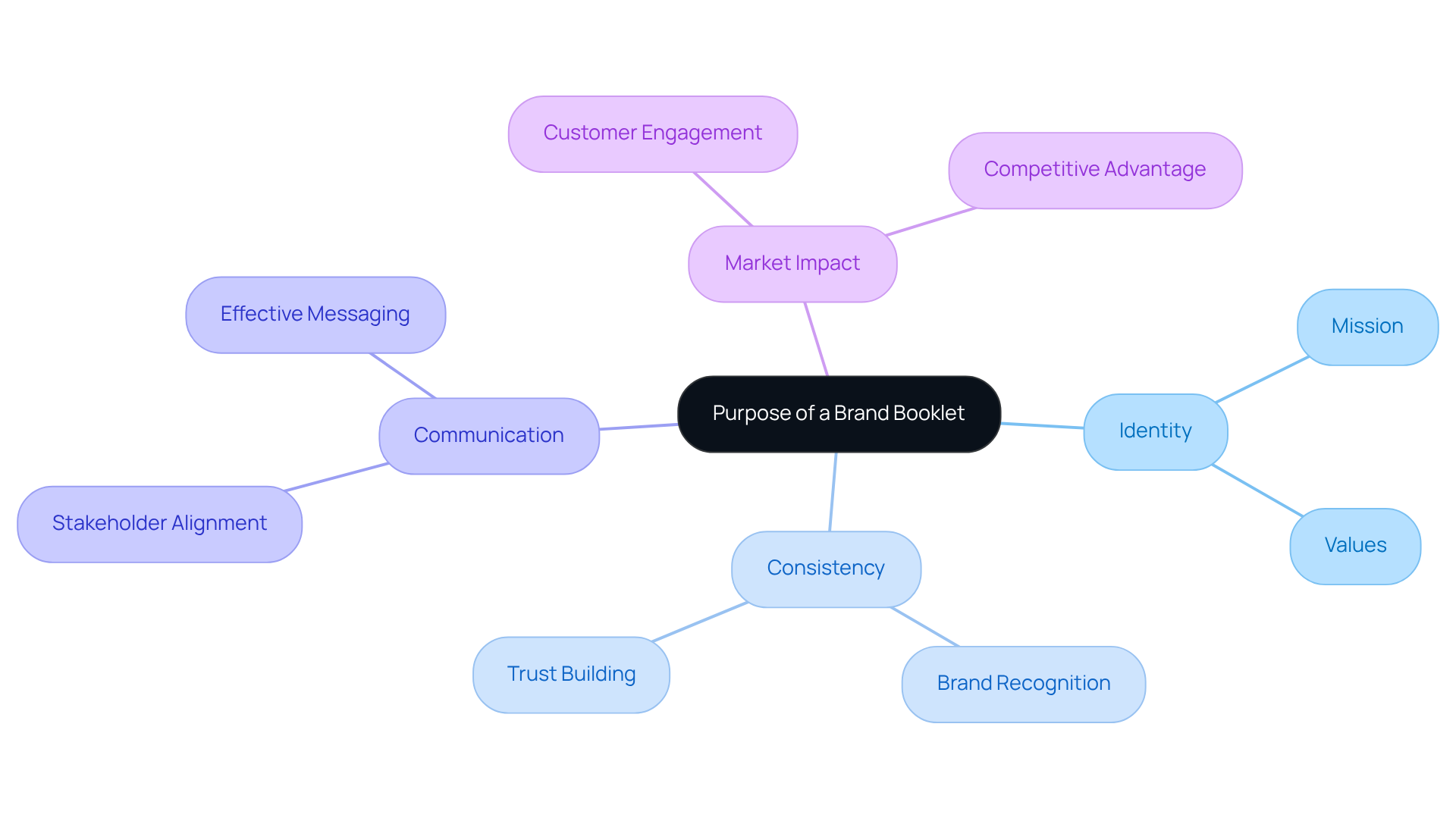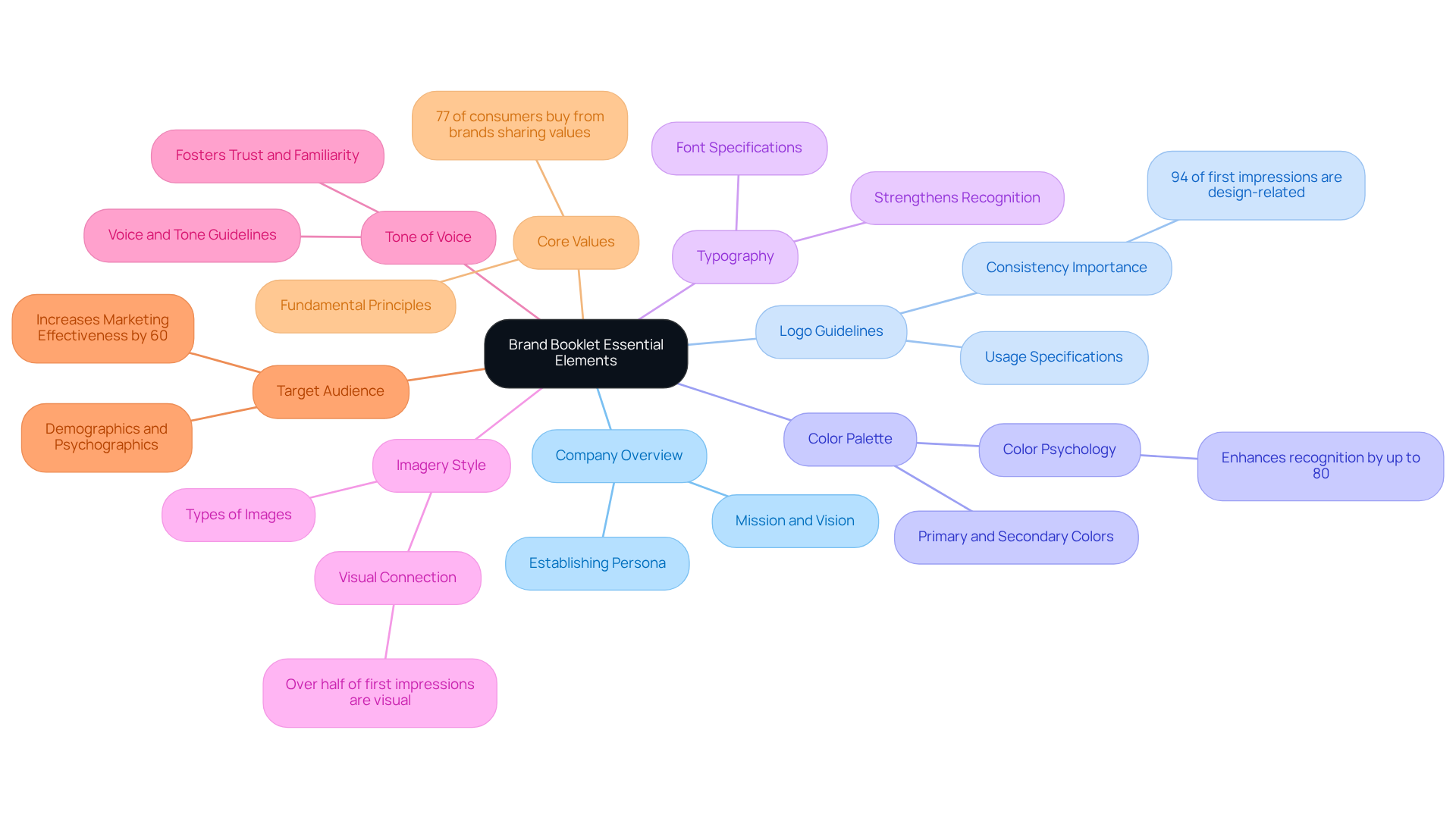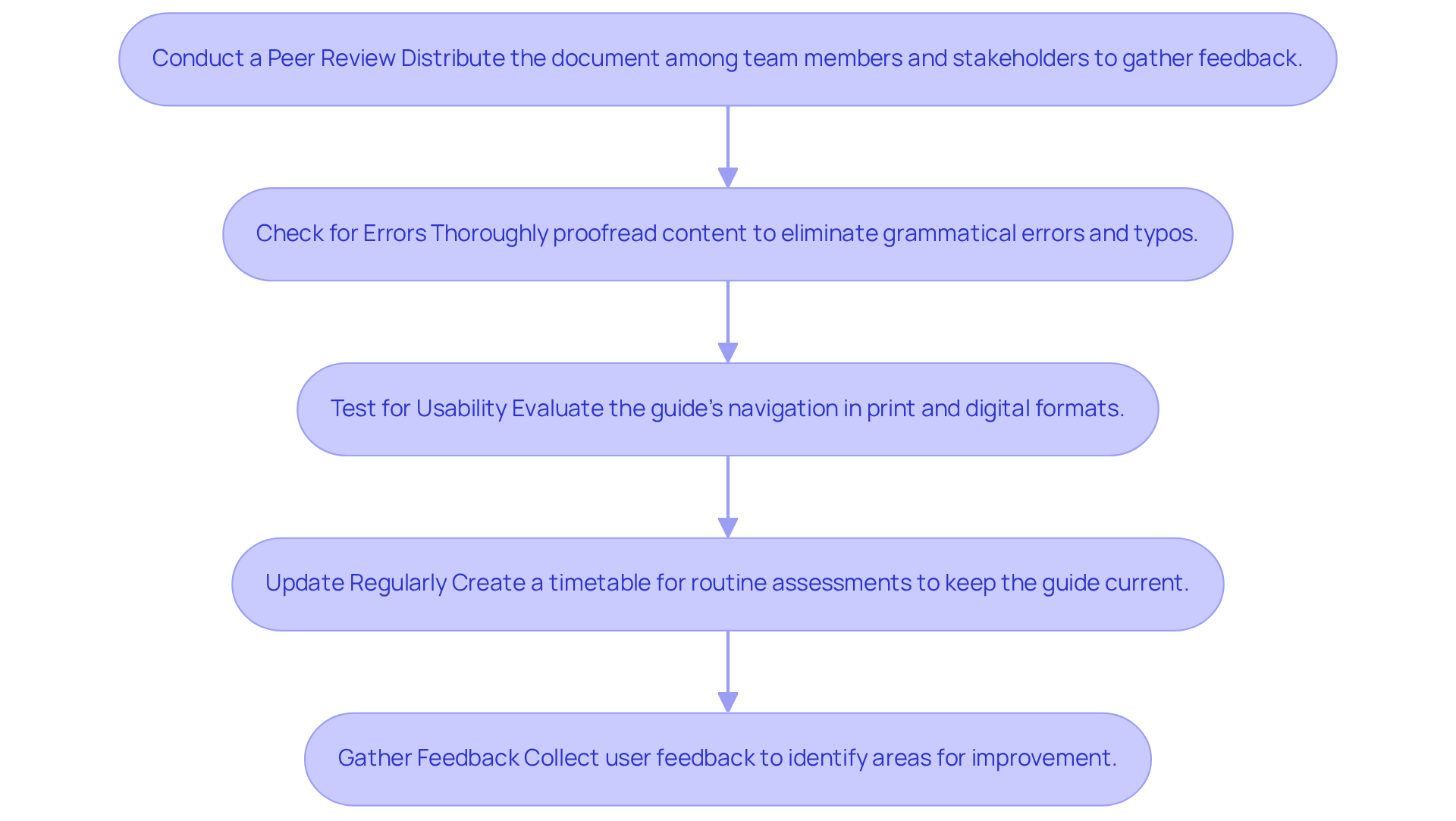Overview
Creating an effective brand booklet can feel overwhelming, especially for tech startup founders who are navigating the complexities of establishing their identity. The challenge lies in ensuring clarity, consistency, and alignment with your organization’s values. When these elements are missing, it can lead to confusion and a lack of trust from your audience, which is something no founder wants to experience.
However, there is hope. By following four essential steps, you can craft a brand booklet that not only resonates with your audience but also fosters a sense of trust. Start by including a comprehensive company overview, which sets the stage for who you are and what you stand for. Next, establish clear logo guidelines that ensure your brand is presented consistently across all platforms. A thoughtfully chosen color palette and typography further enhance your brand identity, creating a cohesive look that speaks to your values.
By focusing on these critical components, you can create a brand booklet that not only reflects your organization’s essence but also connects with your audience on a deeper level. Remember, you’re not alone in this journey; many founders have faced similar challenges and have found strength in community and shared experiences. Embrace this process, and let your brand shine with clarity and confidence.
Introduction
Creating a brand booklet is more than just a design task—it's a crucial step in defining your company's identity and ensuring that your mission resonates with both your internal teams and external audiences. Many organizations face the challenge of effectively communicating their values and vision, which can lead to confusion and inconsistency. This struggle not only affects your marketing efforts but also impacts the trust and recognition you build in a crowded marketplace.
A well-structured brand booklet can serve as a touchstone for consistency, fostering a sense of clarity and connection. So, what are the key elements that can transform a simple document into a powerful branding tool? Let’s explore how you can turn this challenge into an opportunity for growth and engagement.
Define the Purpose and Importance of a Brand Booklet
A serves as a vital resource that encapsulates your organization's identity, mission, and values. Many founders face the challenge of ensuring that all team members and stakeholders grasp the and can communicate it effectively. This lack of clarity can lead to confusion and misalignment, impacting the overall success of the organization.
The importance of a brand booklet lies in its ability to maintain consistency across various platforms and interactions, which is essential for . By articulating the organization's purpose, the brand booklet serves as a reference point for all branding and marketing efforts, aligning everyone involved with the organization's goals and messaging.
At RNO1, we understand that a thoughtfully designed brand booklet not only reflects the essence of the company but also leverages our , such as with Microsoft, to empower modern identities. Our collaborations with industry leaders and innovative startups enable us to craft that resonate across platforms, enhancing marketability through our Return On Design & Digital (RODD) strategies.
For example, our , which was acquired by Airbnb, illustrates how a robust company identity can disrupt markets and foster deeper customer engagement. We invite you to consider how a can support your journey, ensuring that your vision is shared and embraced by all.

Identify Essential Elements to Include in Your Brand Booklet
Creating your brand booklet can feel overwhelming, and it’s crucial to include essential elements that reflect . Let’s explore how these components can ease your journey.
- Company Overview: Start by providing a concise introduction to your organization, detailing its mission and vision. This foundation helps establish your persona and fosters a connection with your audience, making them feel valued.
- Logo Guidelines: Next, include specifications for logo usage, covering variations, placement, and any restrictions. Consistent logo usage is vital; after all, . This consistency is key to shaping your overall image and building trust.
- Color Palette: Define your primary and secondary colors, complete with HEX and RGB codes. Color psychology plays a significant role in marketing, with studies showing that . Choosing the right colors not only evokes emotions but also enhances visibility, making your brand memorable.
- Typography: Specify the fonts for headings, body text, and any other relevant typography guidelines. and aids in readability, ensuring your message resonates effectively with your audience.
- Imagery Style: Provide guidelines on the types of images that align with your identity. Visual elements should connect with your audience, as over half of . Thoughtfully chosen imagery can create a lasting impact.
- Tone of Voice: Outline your company's voice and tone, including examples of language that resonates with your audience. A consistent tone fosters trust and familiarity, which are essential for building lasting relationships with customers. Share your story; it matters.
- Target Audience: Describe your ideal customer, including demographics and psychographics. Understanding your audience can , allowing you to tailor your messaging and strategies with care.
- Core Values: Clearly express the fundamental principles that guide your organization's actions and decisions. Companies that share the same values as their customers experience a greater chance of purchase, with 77% of consumers choosing to buy from organizations that align with their beliefs.
By integrating these components into your brand booklet, you not only enhance your organization's persona but also . This ultimately boosts engagement and loyalty, creating a supportive community around your brand.

Design and Format Your Brand Booklet for Maximum Impact
To design your brand booklet effectively, consider the following nurturing suggestions:
- Choose a Clean Layout: A balanced and organized layout is essential. Implementing a grid system can naturally guide your reader's eye through the content. At RNO1, we understand that every design choice enhances user experience. Prioritizing clarity ensures that your layout reflects the positive impact of your design decisions.
- Incorporate : Segmenting text with headings, subheadings, and bullet points can emphasize key information, making it easier for your readers to digest. It's worth noting that 70% of survey constituents reported that when communicating with existing customers. Our design-focused approach ensures that visual hierarchy is not only functional but also aesthetically pleasing, maximizing engagement through our RODD strategies.
- Use : High-resolution images that are pertinent to your content significantly enhance the overall aesthetic and engagement. Research indicates that original graphics drive the most traffic, underscoring their importance in marketing materials. At RNO1, we prioritize , ensuring that every image reflects your company's essence and contributes to a cohesive user experience.
- Consistent Identity: Maintaining uniformity in your color scheme and typography throughout the publication reinforces your identity. by 3 to 4 times, making it crucial for recognition. As noted, ", ultimately driving sales and customer retention." Our commitment to design-driven solutions ensures that your branding remains cohesive and impactful, as detailed in our brand booklet and aligned with our RODD strategies.
- Interactive Elements: Integrating QR codes or links to digital resources can provide an interactive experience that engages readers further. This aligns with our RODD strategies, maximizing engagement through innovative design.
- Print and Digital Versions: Creating both print and digital formats of the guide accommodates various audiences and use cases, ensuring accessibility and versatility in your branding efforts. RNO1's design philosophy supports creating adaptable materials that cater to diverse needs.

Review and Refine Your Brand Booklet for Clarity and Consistency
To ensure your is effective, it’s important to tackle a common challenge many face: the risk of unclear messaging. This can lead to misunderstandings, which can greatly affect your brand's perception. Here are some nurturing steps to guide you through the process:
- Conduct a Peer Review: Distributing the document among team members and stakeholders allows you to . This collaborative approach not only helps identify potential misunderstandings but also ensures alignment with your brand messaging, fostering a sense of community.
- Check for Errors: Taking the time to thoroughly proofread your content is crucial. in branding elements enhances credibility—research shows that well-proofed materials can boost credibility by up to 70%. This step is vital for projecting professionalism and care in your brand booklet.
- Test for Usability: Evaluating the guide's navigation in both print and digital formats can reveal how easily users can locate information. This and ensuring that the document fulfills its intended function effectively. For instance, highlighted how usability testing can significantly enhance and help achieve marketing goals.
- Update Regularly: It’s important to create a timetable for routine assessments to keep your guide current as your company evolves or as new regulations emerge. Regular updates are vital for maintaining relevance in today's fast-paced market, demonstrating your commitment to quality and care.
- Gather Feedback: After distributing your brand booklet, actively collecting feedback from users can help pinpoint areas for improvement. This ongoing dialogue allows for necessary adjustments, ensuring that the brand booklet continues to be a . As Jared Schwitzke wisely noted, a is essential for impactful branding, emphasizing the importance of continuous refinement based on user input.
By embracing these steps, you not only enhance your brand booklet's effectiveness but also nurture a supportive environment that values input and fosters growth.

Conclusion
A well-crafted brand booklet is essential for any organization seeking to communicate its identity and values effectively. It serves as a foundational tool that ensures all stakeholders are aligned with the company’s vision and can convey it consistently. By encapsulating the essence of the brand, the booklet not only fosters recognition and trust but also acts as a reference point for all branding and marketing efforts.
However, many organizations struggle with this crucial aspect of their identity. Without a clear and cohesive brand booklet, confusion can arise, leading to misaligned messaging and a lack of trust among stakeholders. This can create a disconnect between the organization and its audience, ultimately hindering growth and engagement.
Throughout this guide, we have outlined key components to create an impactful brand booklet. From defining the company’s mission and values to establishing guidelines for logo usage, color palettes, typography, imagery, and tone of voice, each element plays a crucial role in shaping the brand's identity. Additionally, we have emphasized the importance of a clean design, visual hierarchy, and regular updates to maintain clarity and consistency, ensuring that the booklet remains relevant and effective.
In a landscape where brand perception is paramount, the significance of a strong brand booklet cannot be overstated. It not only enhances engagement and loyalty but also cultivates a supportive community around the brand. Organizations are encouraged to embrace these insights and take actionable steps to develop and refine their brand booklets. By doing so, they can drive success and foster deeper connections with their audience, creating a nurturing environment that resonates with their values and mission.
Frequently Asked Questions
What is the purpose of a brand booklet?
A brand booklet serves as a vital resource that encapsulates an organization's identity, mission, and values, ensuring that all team members and stakeholders understand and can effectively communicate the company's vision.
Why is a brand booklet important for an organization?
A brand booklet is important because it maintains consistency across various platforms and interactions, which is essential for building recognition and trust. It acts as a reference point for all branding and marketing efforts, aligning everyone with the organization's goals and messaging.
How does RNO1 approach the design of a brand booklet?
At RNO1, a thoughtfully designed brand booklet not only reflects the essence of the company but also leverages strategic partnerships, such as with Microsoft, to empower modern identities and craft transformative digital experiences.
Can you provide an example of how a brand booklet can impact market engagement?
An example is RNO1's collaboration with RentMethod, which was acquired by Airbnb. This illustrates how a robust company identity can disrupt markets and foster deeper customer engagement.
How can a strong brand booklet support a company's journey?
A strong brand booklet can support a company's journey by ensuring that its vision is shared and embraced by all, leading to better alignment and effectiveness in achieving organizational goals.




